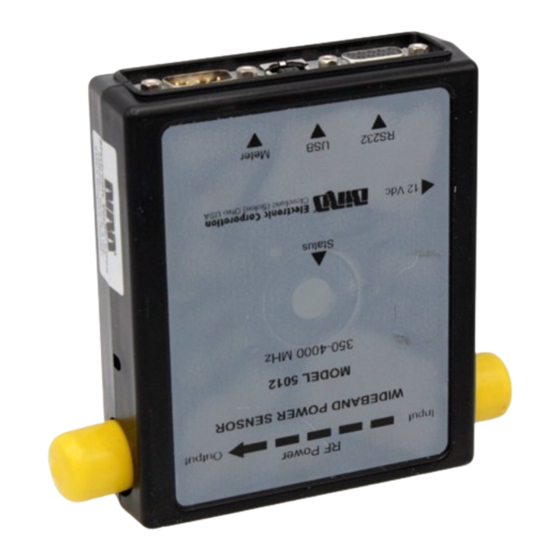
Summary of Contents for BIRD 5012
- Page 1 INSTRUCTION SHEET WIDEBAND POWER SENSOR MODEL 5012 ©Copyright 2003 by Bird Electronic Corporation Instruction Book P/N 920-5012 Rev. A...
- Page 2 Description The Bird 5012 Wideband Power Sensor (WPS) is a Thruline sensor that can measure average, peak, or burst power, VSWR, crest factor, and Complementary Cumulative Distribution Function (CCDF). It can be used with the Bird 5000-EX Digital Power Meter (DPM) and the Bird Virtual Power Meter Software (VPM).
-
Page 3: Zeroing Sensor
Zeroing Sensor Over time, the sensor’s “zero value” (reading with no applied RF power) can drift, making all readings inaccurate by this value. For example, if the zero value is –0.02 W, measuring a 50 W signal will give a reading of 49.98 W, a 0.04% error. Measuring a 1 W signal will give a reading of 0.98 W, a 2% error. - Page 4 VSWR VSWR measures the relation between forward and reflected average power. The Bird Wideband Power Sensor calculates the VSWR from the Forward and Reflected Average Power measurements. Rho and Return Loss are also the same measurement, but in different units:...
- Page 5 Peak Envelope Power Peak power measurements detect amplitude changes as a signal modulates the carrier envelope. The WPS operates in an asynch- ronous cycle: 300 ms of waveform sampling followed by a 50 ms reset period. The peak power is then displayed and the cycle repeats. The display therefore updates about three times per second.
- Page 6 Crest Factor Figure 4 Peak Envelope Power Crest Factor 100 W 10 dB CDMA Signal 100 W Peak 50 W 10 W Ave Average Power Crest factor (CF) is the ratio of the peak and average powers, in dB. The WPS calculates the Crest Factor from the Forward Peak and Average Power measurements.
-
Page 7: Specifications
Specifications Sensor Characteristics Frequency Range 350 MHz to 4 GHz RF Power Range 0.15 W – 150 W Average, 4 – 400 W Peak Maximum Power See Figure 7 on page 9 Impedance, Nominal 50 ohms Insertion Loss, Max: 0.35 – 1 GHz 0.05 dB 1 –... - Page 8 Match Measurement Measurement Range: Return Loss 0 to 23 dB Rho (ρ) 0.07 to 1.0 VSWR 1.15 to 99.9 Forward Power, Min 0.5 W Measurement Uncert. See Figure 6 on page 8 Figure 6 Match Measurement Uncertainty Match Measure Uncertainty Above 3 GHz Below 3 GHz –2...
- Page 9 Figure 7 Maximum Peak Power Max. Peak Power 1000 VSWR = 1 VSWR = 1.5 VSWR = 3 Frequency (GHZ) Burst Average Power Power Range 2 – 150 W average Burst Width 1 µs – 50 ms Repetition Rate, Min 15 Hz Duty Cycle (D) 0.001 –...
- Page 10 Physical and Environmental Specifications Temp, Operating –10 to +50 °C (+14 to +122 °F) Temp, Storage –40 to +80 °C (–40 to +176 °F) Mechanical Shock and MIL-PRF-28800F class 3 Vibration Humidity, Max 95% (non-condensing) Altitude, Max 15,000 ft. (4,500 m) Dimensions, Nominal 4.75”...
- Page 11 RF POWER INPUT OUTPUT WIDEBAND POWER SENSOR MODEL 5012 350 – 4000 MHz 4.6" (116 mm) STATUS 12VDC RS232 METER RS-232 1.3" (33 mm) TO PC TO DPM 3.8" (96 mm)
-
Page 12: Declaration Of Conformity
Products: Wideband Power Sensor Models: 5012 The undersigned hereby declares, on behalf of Bird Electronic Corporation of Cleveland, Ohio, that the above-referenced products, to which this declaration relates, are in conformance with the provisions of the following standards; European Standard EN 61326-1:1997 + Addendums A1:1998 and A2:2001 –...




Need help?
Do you have a question about the 5012 and is the answer not in the manual?
Questions and answers